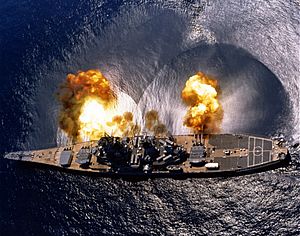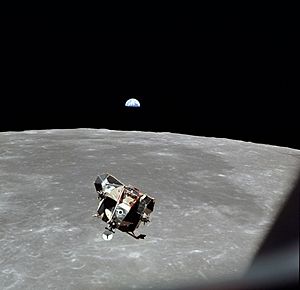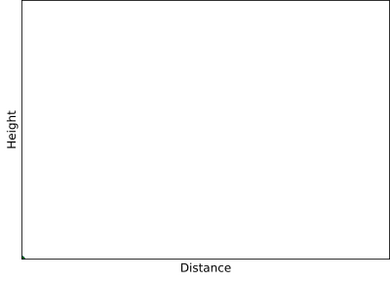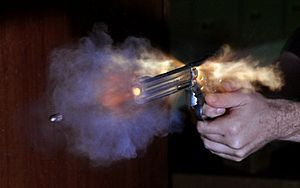Ballistics facts for kids
Ballistics is the study of how things fly through the air, especially after they are launched. It looks at how objects like bullets, rockets, or even a thrown baseball move, what makes them fly, and what happens when they hit something. It's also about designing ways to launch these objects so they go where you want them to.
A ballistic body is an object that is free to move after being pushed or launched. Its movement is affected by forces like the gas pushing it out of a gun, the pull of gravity, or the drag from the air.
A ballistic missile is a special type of missile. It is only guided for a short time at the very start of its flight. After that, it flies through the air following the rules of classical mechanics, like a thrown ball. This is different from a cruise missile, which uses its engines and wings to stay guided throughout its flight.
Contents
History of Ballistics
This section explores how people have launched objects over time.
Early Projectiles
The first known objects launched by people were simple things like stones and spears. People also used throwing sticks.
Scientists found stone-tipped objects in Sibudu Cave, South Africa, that are about 64,000 years old. These might have been thrown by hand or launched with a spear-thrower.
The oldest proof of using bows to shoot arrows dates back about 10,000 years. These were pinewood arrows found in Germany. They had special grooves, showing they were shot from a bow. The oldest bow ever found is about 8,000 years old, discovered in Denmark.
Archery came to the Americas around 4,500 years ago.
The First Guns
The first devices that looked like guns appeared in China around the year 1000 AD. By the 12th century, this technology spread across Asia. It reached Europe by the 13th century.
What Are Projectiles?
A projectile is any object that is launched into space (even if it's just the air around us) by a push or force. While anything moving through space, like a thrown baseball, is a projectile, the word usually means something launched from a ranged weapon. Scientists use special math to figure out how a projectile will fly.
Examples of projectiles include balls, arrows, bullets, artillery shells, and rockets.
How Projectiles Are Launched
People have invented many ways to launch objects.
Throwing by Hand

Throwing is when you launch a projectile using your hand. Humans are very good at throwing, much better than most other animals. This skill might have developed over millions of years. Some athletes can throw a ball at 90 miles per hour! This is much faster than a chimpanzee, which can throw at about 20 miles per hour. Our shoulder muscles and tendons are designed to store energy and then release it quickly to throw an object.
Slings
A sling is a simple weapon used to throw a blunt object, like a stone or a special "sling-bullet".
A sling has a small pouch in the middle of two cords. You put the stone in the pouch. You put your middle finger or thumb through a loop on one cord. You hold a tab at the end of the other cord between your thumb and pointer finger. You swing the sling in a circle, and at just the right moment, you let go of the tab. This sends the projectile flying towards its target.
Bows
A bow is a flexible piece of material that shoots arrows. A string connects the two ends of the bow. When you pull the string back, the bow bends and stores energy. When you release the string, this stored energy turns into the speed of the arrow, sending it forward. Archery is the sport or art of shooting arrows from bows.
Catapults
A catapult is a machine used to launch a projectile a long distance without using explosives. Catapults were very important in ancient and medieval siege engines, used to attack castles. The word "catapult" comes from ancient Greek words meaning "to toss down" or "to hurl." The ancient Greeks invented catapults.
Guns

A gun is usually a tube-shaped weapon or device designed to shoot projectiles. The projectile can be solid, liquid, gas, or even energy. It can be free-flying, like bullets, or attached, like Taser probes. Most guns work by using gas pressure. This gas pressure is created by burning a special powder, or it can be stored compressed gas. The gas pushes the projectile down the tube, giving it enough speed to keep going once it leaves the end of the tube, called the muzzle. Some newer guns use electromagnetic fields to launch projectiles instead of gas.
Rockets
A rocket is a missile, spacecraft, aircraft, or other vehicle that gets its push (called thrust) from a rocket engine. Rocket engines work by throwing gas out the back very, very fast. This pushes the rocket forward. This is based on a rule in physics called action and reaction.
Rockets are very powerful and can go extremely fast. They don't need air to work, so they are perfect for traveling in space.
Rockets were first used for military and fun purposes in China around the 13th century. But they became much more important in the 20th century. Rockets made the Space Age possible, including sending humans to the Moon. Today, rockets are used for fireworks, weaponry, ejection seats, launching satellites, human spaceflight, and space exploration.
Most powerful rockets are "chemical rockets." They create their exhaust by burning special rocket propellant. These fuels store a lot of energy and can be dangerous, but careful design and testing make them safe to use.
Parts of Ballistics
Ballistics is often divided into four main areas of study:
- Internal ballistics: This looks at what happens inside the gun or launcher to make the projectile start moving.
- Transition ballistics: This studies the short moment when the projectile leaves the launcher and starts its free flight.
- External ballistics: This is the study of how the projectile flies through the air, including its path or trajectory.
- Terminal ballistics: This looks at what happens when the projectile hits its target and the effects it has.
How Ballistics Is Used
Forensic Ballistics
Forensic ballistics is used in legal cases. It involves looking at bullets and where they hit to find information that can help a court. For example, experts can examine marks on a bullet or shell casing to see if it came from a specific gun. This is sometimes called "ballistic fingerprinting."
Astrodynamics

Astrodynamics is like ballistics for space. It uses the rules of how things move to solve problems about rockets and spacecraft moving in space. Scientists use Newton's laws of motion and Newton's law of universal gravitation to figure out how these objects will travel. It's a very important part of designing and controlling space missions.
See also
 In Spanish: Balística para niños
In Spanish: Balística para niños






